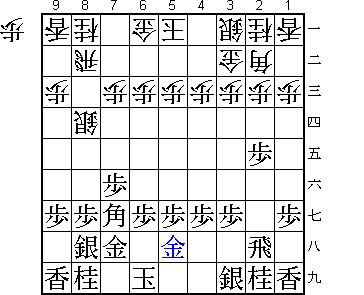
After 1. G-5h
Moves from Diagram 1:
1... S-8e
2. P-2d Px2d
3. Rx2d P*2c
4. R-2f ---> (Diagram 2)
There are a few basics to learn about defence. The first thing
you should learn is that simply apologizing or bowing is never
defence. Endure it when you must, but always be alert for the chance
to counterattack. That is real defence. Don't be under your
opponent's thumb. He may presume on such an attitude, and your
timidness will spur him on his attack. Unless you forget the above,
you will learn defensive techniques naturally and gradually. Now let
me begin my lessons with some examples.
In Diagram 1, white is going to attack with the "bogin attack" on
the 8 file.
 |
Diagram 1
After 1. G-5h Moves from Diagram 1:
|
At the position of Diagram 1, the most important thing for black is to have a firm conviction that black's defence with three men, bishop, gold and silver on the 8 file will never be broken by white's attack with only 2 men, rook and silver. A vague anxiety about the opponent's attack may cause black to make a mistake. The aim of white's S-8e is to capture the pawn at 7f for nothing. If this comes true, white will easily stand better. However, if black pushes the pawn to 7e to avoid the attack, then black will be easily defeated with this variation: 1... S-8e 2. P-7e S-7f 3. B-5i P-3d 4. P-2d Px2d 5. Rx2d P*2c 6. R-2f Bx8h+ 7. Gx8h Sx8g+ (Diagram A). The reason for this disaster is that black was too fearful of white's attack.
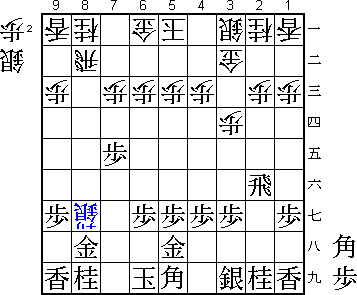 |
Diagram A
After 7... Sx8g+ |
If white wants the pawn at 7f, let him have it! Ignore white and push the pawn to 2d to exchange pawns. This move is better because black can gain a pawn in hand, which will be used for defence in the future. White's 3... P*2c is indispensable. If 3... Sx7f, avariciously capturing the pawn, black plays: 4. P*2c S-7g+ 5. Sx7g. (Diagram B)
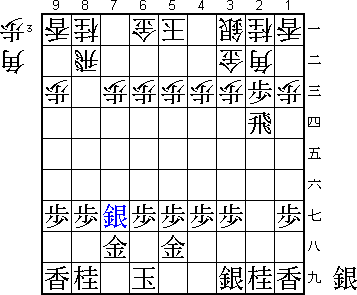 |
Diagram B
After 5. Sx7g |
Initially white makes a profit, but a bishop will soon be lost, so that in the end, white loses a silver. Losing a silver at such at early stage is so devastating that even a strong player could not win with white. Black's R-2f, defending the pawn at 7f, is a good move. Black could simply play R-2f without exchanging pawns, but this is not as profitable because black does not gain a pawn in hand. Always play a more profitable move, no matter how small it is. That attitude is the key to victory. Beginners jump at a good move as soon as they find it, but you should strive to make a good move better. This idea is needed to gain the advantage. Calm play is always like this.
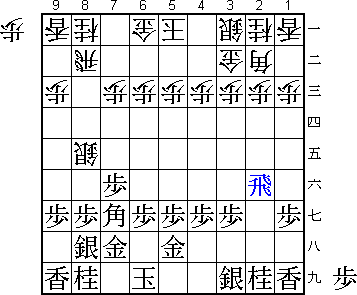 |
Diagram 2
After 4. R-2f Moves from Diagram 2:
|
White's 4... P*8f is the move he was aiming for. It is a natural move that utilizes the silver at 8e. If white plays 4... P-7d instead of 4... P*8f, still aiming to attack the bishop's head, black will counterattack with this variation: 5. B-5e R-9b 6. N-7g. White's bogin attack ends in failure. Similarly, 4... P-3d (instead of 4... P*8f) is also an idea. However, the bogin still fails as white's silver is ejected with the variation: 5. S-4h K-4a 6. B-2b+ Sx2b 7. N-7g (Diagram D). Most of the time, you will be defeated if you falter in the middle of your attack. You must resolve to accomplish your plan even if you encounter some difficulties. That is why white must not consider moves other than 4... P*8f.
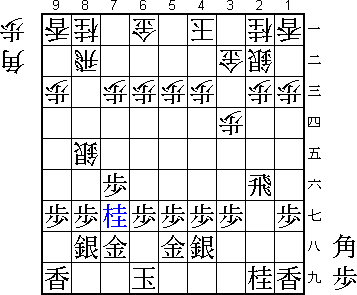 |
Diagram D
After 6. N-7g |
At first glance, black seems to be in trouble after 4... P*8f. If black plays 5. Px8f, then 5... Sx8f 6. B-5i P*8g 7. S-7i P-3d (Diagram E).
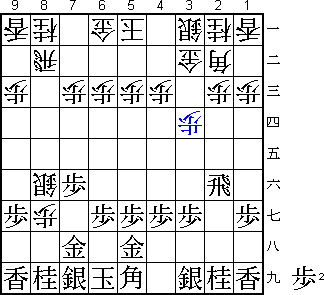 |
Diagram E
After 7... P-3d |
At Diagram E, black is obviously worse, because he is confined by white's pressure. If black ignores white's 4... P*8f and plays 5. S-4h, white will strongly occupy the 8f point and black runs out of moves after the variation: 5... Px8g+ 6. Sx8g P*8f. White can neither capture nor ignore the pawn at 8f. Then did white's bogin attack result in success? The answer is "no". This is the situation that demands a counterattacking move for defence and if you find it, you never have to fear the bogin attack. White attacks with two men, rook and silver, and black defends with three men, bishop, gold and silver. Additionally, the rook at 2f is well placed for black's defence. Naturally it must be quite easy to thwart white's attack by the cooperation among these pieces. The difficulty is how black lets them cooperate. Is there a way for that? There is. Activate the rook at 2f horizontally by advancing the endangered pawn at 7f. This is an example of "killing two birds with one stone".
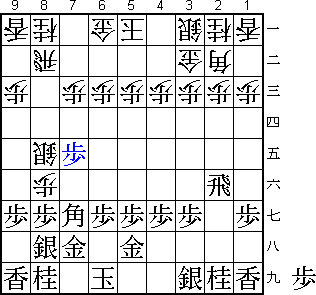 |
Diagram 3
After 5. P-7e Moves from Diagram 3:
|
White's attack with 5... Px8g+ is very energetic. If the pawn at 8f is captured by black, the position will be quite terrible for white. 6... P*8f is a natural follow-up move. With a move like the silver at 8e retreats, it cannot be helped but to say that you do not know anything about victory and defeat. In Shogi, there is a move that must be played even knowing your men will be lost. Even if you make a mistake after such a move, that experience will make you a better player. To exchange bishops and avoid the loss of a pawn by 6... P-3d (instead of 6... P*8f) fares poorly for white because of the variation: 7. P*8f Bx7g+ 8. Nx7g S-9d 9. S-4h (Diagram F).
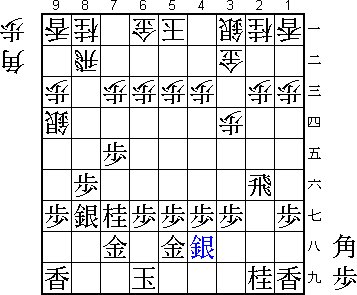 |
Diagram F
After 9. S-4h |
A typical fault of beginners is to be fearful of a small apparent
loss. So they avoid it, but at the cost of allowing much greater
damage that is not immediately apparent. They will never make
progress if they continue to play that way.
Black's 7. Sx8f is doubtless the only move to respond to white's
attack. If black, fearing complications, plays 7. S-9h instead, then
white plays 7... S-4b 8. S-4h K-4a (Diagram G).
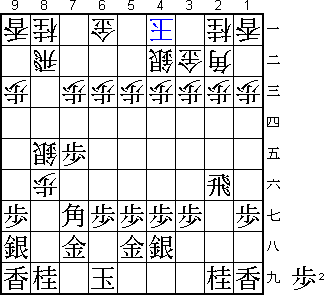 |
Diagram G
After 8... K-4a |
White's castling will be completed and his occupation of the 8
file will gradually lead to a favorable position for him. The
"peace-at-any-price" principle, in the case of Shogi, is never welcome
and it prevents you from making progress.
After white's 7... Sx8f, black's 8. Rx8f instead of 8. Bx8f may
be considered. However, it is semeai (mutual attack) which will not
be favorable for black after 8... Rx8f 9. Bx8f R*2f 10. R*8b G-7a 11.
R-8e+ (11. S*5b K-4b is to white's advantage) R-2i+ (Diagram H).
Since white has no pawn in hand, 8. Bx8f is better.
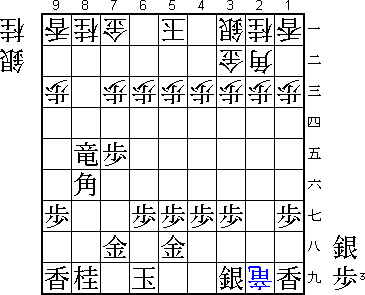 |
Diagram H
After 11... R-2i+ |
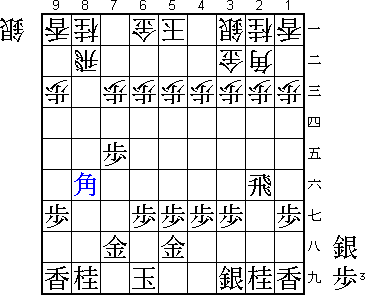 |
Diagram 4
After 8. Bx8f Moves from Diagram 4:
|
This is a good time to utilize white's bishop by 8... P-3d. Cooperation of rook and bishop is, above all, important to succeed in your attack. Beginners are apt to forget about this cooperation, although they are worried about the utilization of their rook and their bishop separately. Such planning does not work effectively. For instance, instead of 8... P-3d, white can try attacking by 8... S*9e. However, white will be defeated with this variation: 9. Bx9e Rx8i+ 10. G-7i +R-8e 11. R-8f +Rx8f 12. Bx8f R*2f 13. R*8e Rx2i+ 14. S*2h (Diagram I). White's promoted rook is locked on 2i, and black threatens both Rx8a+ and S*3h. In the above variation, if 10... +R-9i instead of 10... +R-8e, black plays 11. S*8h +R-9h 12. S*8g (Diagram J).
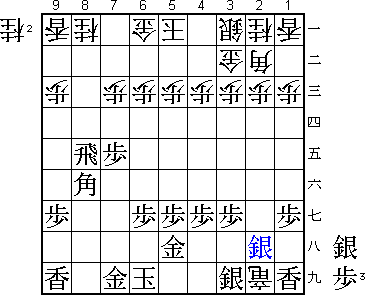 |
Diagram I
After 14. S*2h |
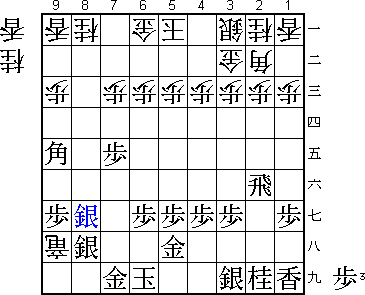 |
Diagram J
After 12. S*8g |
White's promoted rook will be captured. On the other hand, if
white played 11... +Rx9e capturing the bishop, instead of 11... +Rx8f,
black would play 12. Rx8a+ aiming for mutual attack. This is
disadvantageous for white because his castle is weak. I am sure that
after studying this example you understand well that the attack by the
rook alone does not work at all.
Black's 9. P*8h is a strong defence. Pushing the pawn to 6f
carelessly allows the bishop at 8f to be captured for nothing, and 9.
N-7g is dangerous because it blocks the bishop's retreat. Defence
should be as strong as possible. At diagram 5, white's bogin attack
looks like a complete failure.
 |
Diagram 5
After 9. P*8h Moves from Diagram 5:
|
White has only a silver in hand. Sadly, he has no pawn in hand so no clever attack by white can be found in this situation. Furthermore, if black pushes the pawn 10. P7d, white will be overwhelmed because of black's threats 11. B-5c+ or 11. P-7c+ Nx7c 12. P*7d. It is quite regrettable for white to give up the attack, but protecting the 5th file by 9... S-4b is imperative. Forcing the attack by 9... S*8e in frustration will never be effective because black defends as follows: 10. B-6h S-7f 11. K-7i (Diagram K), and the silver at 7f will be captured soon. Most of the time, attacking prematurely gives an opponent a chance to counterattack, so attacking should always be started with a proper evaluation of the outcome.
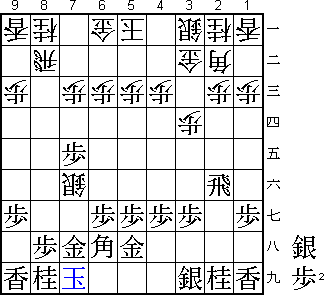 |
Diagram K
After 11. K-7i |
In the above variation, 10. B-7g Bx7g+ 11. Nx7g instead of 10. B-6h seems better as the knight at 7g is threatening the silver at 8e. However this defence is not favorable to black, because white will move the silver to 8f aiming at B*4d or Sx7g+ (Diagram L).
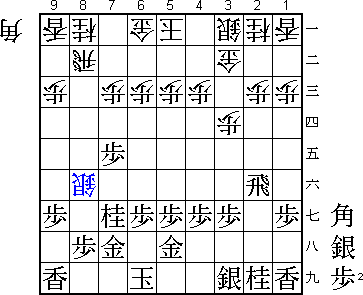 |
Diagram L
After 11... S-8f |
Also in the same variation, if black captures the silver immediately with 11. Rx7f instead of 11. K-7i, he will be strongly attacked by 11... Bx8h+. This is a problem for black. In any case, an inviting move is apt to have a pitfall. It is very important to make it a habit to cool down and think. Again, don't be overcome with greed and move without thinking. Instead of white's 9... S-4b, 9... B-4d in order to evict the rook at 2f and capture the bishop at 8f for nothing may be considered. However the rook will escape to 3f, and then to 7f if white attacks the rook again by 10... S*4e. (Diagram M) White's effort will be wasted entirely. Remember to correct the weaknesses in your position when no attacking move is found.
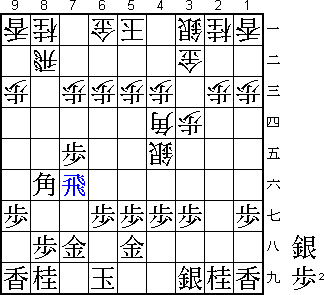 |
Diagram M
After 11. R-7f |
After white's careful defence by 9... S-4b, black's bishop at 8f is no longer effective. If anything, it has become a cumbersome piece that will make a good target for white. That is why black moves the bishop to 7g, offering to exchange bishops. The bishop can work more effectively in the future if it is in hand. The movements of the pieces on the board are limited, but the pieces in hand are more accommodating. If a piece on the board is not working, be alert for an opportunity to exchange it. Now, at the position after the bishops were exchanged and black played 11. Nx7g, white has no good attack. His bogin attack has failed entirely. In other words, black's defence was very successful. After this, if black aims at attacks such as B*5e or R-7f, he will gradually lead the game. Black is advantageous because white has no pawn in hand.
 |
Diagram 6
After 11. Nx7g |
Translated by Yoshinori Sawada & Randy Andrews
[ Table of Contents | Shogi Nexus Index ]